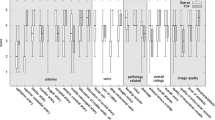Abstract
Object
The aim of this study was to investigate the acceleration of peripheral Time-of-Flight magnetic resonance angiography using Compressed Sensing and parallel magnetic resonance imaging (MRI) while preserving image quality and vascular contrast.
Materials and methods
An analytical sampling pattern is proposed that combines aspects of parallel MRI and Compressed Sensing. It is used in combination with a dedicated Split Bregman algorithm. This approach is compared with current state-of-the-art patterns and reconstruction algorithms.
Results
The acquisition time was reduced from 30 to 2.5 min in a study using ten volunteer data sets, while showing improved sharpness, better contrast and higher accuracy compared to state-of-the-art techniques.
Conclusion
This study showed the benefits of the proposed dedicated analytical sampling pattern and Split Bregman algorithm for optimizing the Compressed Sensing reconstruction of highly accelerated peripheral Time-of-Flight data.







Similar content being viewed by others
References
Meaney JFM (2003) Magnetic resonance angiography of the peripheral arteries: current status. Eur Radiol 13(4):836–852
Donoho DL (2006) Compressed sensing. IEEE Trans Inf Theory 52(4):1289–1306
Pruessmann KP, Weiger M, Scheidegger MB, Boesiger P (1999) SENSE: sensitivity encoding for fast MRI. Magn Reson Med 42(5):952–962
Griswold MA, Jakob PN, Heidemann RM, Nittka M, Jellus V, Wang J, Kiefer B, Haase A (2002) Generalized autocalibrating partially parallel acquisitions (GRAPPA). Magn Reson Med 47:1202–1210
Qu P, Luo J, Zhang B, Wang J, Shen GX (2007) An improved iterative SENSE reconstruction method. Concept Magn Reson B 31B:44–50
Liu B, King K, Steckner M, Xie J, Sheng J, Ying L (2009) Regularized sensitivity encoding (SENSE) reconstruction using Bregman iterations. Magn Reson Med 61(1):145–152
Lustig M, Donoho D, Pauly JM (2007) Sparse MRI: the application of compressed sensing for rapid MR imaging. Magn Reson Med 58(6):1182–1195
Goldstein T, Osher S (2009) The Split Bregman method for L1-regularized problems. SIAM J Imaging Sci 2:323–343
Aelterman J, Luong H, Goossens B, Pizurica A, Philips W (2010) COMPASS: a joint framework for parallel imaging and compressive sensing in MRI. In: Proceedings of the IEEE international conference on image processing (ICIP 2010), Hong Kong, China, Sept 26–29 2010, pp 1653–1656
Facchinei F, Pang J (2003) Finite-dimensional variational inequalities and complementarity problems, vol I and II. Springer, Berlin
Lustig M, Alley M, Vasanawala S, Donoho DL, Pauly JM (2009) L1SPIR-iT: autocalibrating parallel imaging compressed sensing. In: Proceedings of the annual meeting ISMRM, Honolulu, USA, April 18–24 2009, p 334
Osher R, Fatemi E (1992) Nonlinear total variation based noise removal algorithms. Phys D 60(1–2):259–268
Block KT, Uecker M, Frahm J (2007) Undersampled radial MRI with multiple coils. Iterative image reconstruction using a total variation constraint. Magn Reson Med 57(6):1086–1098
Nocedal F (1980) Updating quasi-Newton matrices with limited storage. Math Comput 35(151):773–782
Plonka G, Ma J (2011) Curvelet–wavelet regularized split bregman iteration for compressed sensing. Int J Wavelets Multires 9(1):79–110
Ramani S, Fessler J (2011) Parallel MR image reconstruction using augmented Lagrangian methods. IEEE Trans Med Imaging 30(3):694–706
Wang Z, Bovik A, Sheikh H, Simoncelli E (2004) Image quality assessment: from error visibility to structural similarity. IEEE Trans Image Process 13(4):600–612
Li D, Carr JC, Shea SM, Zheng J, Deshpande VS, Wielopolski PA, Finn JP (2001) Coronary arteries: magnetization-prepared contrast-enhanced three-dimensional volume-targeted breath-hold MR angiography. Radiology 219(1):270–277
Hutter J, Grimm R, Forman C, Hornegger J, Schmitt P (2012) Vessel adapted regularization for iterative reconstruction in MR angiography. In: Pipe J (ed) Proceedings of the 21st annual meeting of the ISMRM. Melbourne, Australia, May 5–11, 2012
Edelman R, Sheehan J, Dunkle E, Schindler N, Carr J, Koktzoglou I (2010) Quiescent-interval single-shot unenhanced magnetic resonance angiography of peripheral vascular disease: technical considerations and clinical feasibility. Magn Reson Med 63(4):951–958
Conflict of interest
The author Jana Hutter declares that she has no conflict of interest. Christoph Forman, Robert Grimm and Peter Schmitt are employees of Siemens AG, Healthcare Sector, Magnetic Resonance, Application Development.
Ethical standards
The manuscript does not contain clinical studies or patient data. All volunteers gave their informed consent prior to inclusion in the study.
Author information
Authors and Affiliations
Corresponding author
Appendix: Formulation of the split problem sub-problems
Appendix: Formulation of the split problem sub-problems
Starting from Eq. (3), the inclusion of the residual errors \({\bf b}_{x},{\bf b}_{y},{\bf b}_{w}\in {\mathbb {C}}^N\) yields the formulation in two steps, given in Eqs. (4–5).
The minimization problem for the \(\hbox {L}_2\) component equals
The sub-problems for the wavelet and total variation terms are formulated as
Rights and permissions
About this article
Cite this article
Hutter, J., Grimm, R., Forman, C. et al. Highly undersampled peripheral Time-of-Flight magnetic resonance angiography: optimized data acquisition and iterative image reconstruction. Magn Reson Mater Phy 28, 437–446 (2015). https://doi.org/10.1007/s10334-014-0477-9
Received:
Revised:
Accepted:
Published:
Issue Date:
DOI: https://doi.org/10.1007/s10334-014-0477-9




